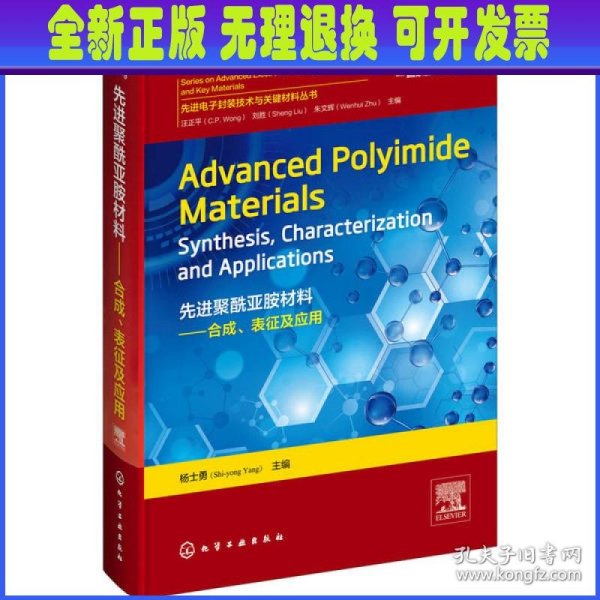【全新正版】 先进聚酰亚胺材料--合成表征及应用(英文版)(精)/先进电子封装技术与关键材料丛书
举报
全新正版图书,支持七天退换,可开具电子发票。
-
作者:
编者:杨士勇|责编:吴刚|总主编:汪正平//刘胜//朱文辉
-
出版社:
化学工业出版社
-
ISBN:
9787122334985
-
出版时间:
2018-12
-
装帧:
精装
-
开本:
16开
-
作者:
编者:杨士勇|责编:吴刚|总主编:汪正平//刘胜//朱文辉
-
出版社:
化学工业出版社
-
ISBN:
9787122334985
-
出版时间:
2018-12
售价
¥
224.41
7.5折
定价
¥298.00
品相
全新
上书时间2024-04-08
卖家超过10天未登录
-
-
商品描述:
-
作者简介
杨士勇,中国科学院化学研究所研究员、高技术材料实验室主任;1982年于兰州大学获得学士学位,1985年于中国科学院化学研究所获硕士学位,1988年于南开大学获得博士学位;1988~1992年在中国科学院上海有机化学研究所任助理研究员,1992年3月~1996年5月年在美国纽约州立大学布法罗分校及芝加哥大学从事博士后研究,1996年至今在中国科学院化学研究所先后任副研究员、研究员。多年来一直从事耐高温聚酰亚胺材料的基础及应用基础研究,发表研究论文200余篇,申请发明专利100余项,获得授权专利70多项。
目录
Preface ix
List of Contributors xi
About the Editor xii
Chapter 1 Advanced Polyimide Films
Shi-Yong Yang and Li-Li Yuan
1.1 Introduction
1.2 Chemistry of Polyimide Films
1.2.1 Thermal Imidization
1.2.2 Chemical Imidization
1.3 Thermal Curing of Polyimide Films
1.3.1 Thermal Imidization Process
1.3.2 Influence of Curing Temperatures on Film’s Properties
1.4 Structures and Properties of Polyimide Films
1.4.1 Advanced Polyimide Films
1.4.2 Low-CTE Polyimide Films
1.4.3 Transparent Polyimide Films
1.4.4 Atomic Oxygen-resistant Polyimide Films
1.5 Surface Modification of Polyimide Films
1.6 Applications of Polyimide Films
1.6.1 Electric Insulating Applications
1.6.2 Electronic and Optoelectronic Applications
1.6.3 Aerospace Applications
1.7 Summary
REFERENCES
Chapter 2 Advanced Polyimide Fibers
Qing-Hua Zhang, Jie Dong and De-Zhen Wu
2.1 Introduction
2.2 Synthesis of Spinning Resin Solutions
2.2.1 “Two-Step” Polymerization Method
2.2.2 “One-Step” Polymerization Method
2.3 Preparation of Polyimide Fibers
2.3.1 Wet-Spinning Method
2.3.2 Dry-Spinning Method
2.3.3 Other-Spinning Methods
2.4 Structure and Properties of Polyimide Fibers
2.4.1 Aggregation Structure of Polyimide Fibers
2.4.2 Chemical Structure-Property Relationship
2.4.3 Properties of Polyimide Fibers
2.5 Applications of Polyimide Fibers
2.5.1 Production of Polyimide Fibers
2.5.2 Application of Polyimide Fibers
2.6 Summary
REFERENCES
Chapter 3 Polyimide Matrices for Carbon Fiber Composites
Shi-Yong Yang and Mian Ji
3.1 Introduction
3.2 NA-endcapped Thermoset Matrix Resins
3.2.1 Chemistry
3.2.2 Structures and Properties
3.3 PE-endcapped Oligoimide Resins
3.3.1 Chemistry
3.3.2 Structures and Properties
3.4 Properties of Polyimide/Carbon Fiber Composites
3.4.1 Preparation of PMR-type Resin Prepregs
3.4.2 Fabrication of Carbon Fiber Composites
3.4.3 Properties of NA-Endcapped Polyimide Composites by Autoclave
3.4.4 Properties of PE-Endcapped Polyimide Composites by Autoclave
3.4.5 Properties of PE-Endcapped Polyimide Composites by RTM
3.5 Applications of Polyimide/Carbon Fiber Composites
3.6 Summary
REFERENCES
Chapter 4 Super Engineering Plastics and Foams
Shi-Yong Yang, Hai-Xia Yang and Ai-Jun Hu
4.1 Introduction
4.2 Compression-Molded Polyimide Materials
4.3 Injection and Extrusion Processed Polyimide Materials
4.4 Structures and Melt Processabilities of Aromatic Polyimide Resins
4.4.1 Polyimide Backbone Structures
4.4.2 Controlled Molecular Weights
4.5 Meltable Thermoplastic Polyimide Composites
4.6 Reactive End-Capped Meltable Polyimide Resins
4.6.1 NA-end-capped Meltable Polyimide Resins
4.6.2 PE-end-capped Meltable Polyimide Resins
4.7 Heat-Resistant Polyimide Foams
4.7.1 Introduction
4.7.2 Opened-Cell Soft Polyimide Foams
4.7.3 Closed-Cell Rigid Polyimide Foams
4.8 Thermally Stable Flexible Polyimide Aerogels
4.9 Summary
REFERENCES
Chapter 5 Polyimides for Electronic Applications
Qing-Hua Lu and Feng Zheng
5.1 Introduction
5.2 Polyimide Materials for Microelectronics
5.2.1 Combined Property Requirements
5.2.2 Typical Applications
5.2.3 Structures and Properties of Polyimide Materials for Microelectronics
5.3 Polyimide Materials for Optoelectric Planar Displays
5.3.1 Liquid Crystal Alignment Layers
5.3.2 Mechanical Rubbing Alignment Polyimides
5.3.3 Photoinduced Alignment PIs
5.3.4 The Microgroove Polyimide Surfaces
5.3.5 Langmuir–Blodgett Polyimide Films
5.4 Polyimide Materials for Optoelectronic Flexible Displays
5.4.1 Combined Property Requirements
5.4.2 Polyimides for Flexible Electronic Substrates
5.5 Polyimide Materials for Electronic Memories
5.5.1 Introduction
5.5.2 Polyimides for Resistive-type Memory Devices
5.5.3 Polyimides for Transistor-type Memory Devices
5.6 Summary
REFERENCES
Chapter 6 Polyimide Gas Separation Membranes
Xiao-Hua Ma and Shi-Yong Yang
6.1 Introduction
6.2 Mechanisms of Gas Separation and Testing Methods
6.2.1 Gas Transport Mechanism
6.2.2 Apparatus for Testing Gas Transport Properties
6.3 Structures and Properties of Polyimide Membranes
6.3.1 Isomer Structure Effects From Diamines
6.3.2 Substitution and Geometric Effects From Diamines
6.3.3 Chemical Structure Effects of Dianhydrides
6.4 Intrinsically Microporous Polyimide Membranes
6.5 Hydroxyl-functionalized Polyimide and Its Derived Polybenzoxazole Membranes
6.5.1 Hydroxyl-functionalized Polyimide Membranes
6.5.2 Thermally Rearranged Polybenzoxazole (TR-PBO) Membranes
6.5.3 Applications of TR-PBO Contents Membranes
6.6 Polyimide-Derived Carbon Molecular Sieve Membranes
6.6.1 Formation of CMSMs
6.6.2 Conversion From Polyimide to CMSMs
6.6.3 Structures and Properties of CMSMs
6.7 In Summary
REFERENCES
Chapter 7 Polyimide Proton Exchange Membranes
Jian-Hua Fang
7.1 Introduction
7.2 Monomer Synthesis
7.2.1 Synthesis of Sulfonated Diamines
7.2.2 Synthesis of Six-membered Ring Dianhydrides
7.3 Polyimide Preparations
7.3.1 Preparation From Sulfonated Diamines
7.3.2 Preparation From Sulfonated Dianhydrides
7.3.3 Synthesis via Postsulfonation
7.3.4 Block Copolymerization
7.4 Ion Exchange Membrane Properties
7.4.1 Solubility
7.4.2 Thermal Stability
7.4.3 Water Uptake and Swelling Ratios
7.4.4 Proton Conductivity
7.4.5 Water Resistance
7.4.6 Radical Oxidative Stability
7.4.7 Methanol Permeability
7.5 Fuel Cell Performance
7.6 Summary
REFERENCES
Chapter 8 Soluble and Low-k Polyimide Materials
Yi Zhang and Wei Huang
8.1 Introduction
8.2 Structures and Properties of Soluble Aromatic Polyimides
8.2.1 Soluble Polyimides With Flexible Backbones
8.2.2 Soluble Polyimides With Asymmetric Structures
8.2.3 Soluble Polyimides With Alicyclic Structures
8.2.4 Soluble Polyimides With Side Groups
8.3 Applications of Soluble Aromatic PIs
8.3.1 Second-order Nonlinear Optical (NLO) Materials
8.3.2 Memory Device Materials
8.3.3 Compensator Materials for Liquid Crystal Displays
8.3.4 Gas Separation Materials
8.3.5 Other Applications
8.4 Low-k Polyimide Materials
8.4.1 Introduction
8.4.2 Impact Factors on Dielectric Properties
8.4.3 Structures and Dielectric Properties of Polyimides
8.4.4 Low-k Polyimides With Porous Structures
8.4.5 Organic-Inorganic Hybrid Polyimide Materials
8.4.6 Intrinsic Low-k Polyimide Materials
8.4.7 Summary
REFERENCES
Appendix Unit of Measurement Conversion Table
内容摘要
优选聚酰亚胺材料,由于具有优异的耐热性、综合力学性能、电学性能和化学稳定性等,在航空、航天、微电子、平面显示、电气绝缘等高技术领域具有广泛的应用前景。本书系统介绍了优选聚酰亚胺材料的合成、性能和应用。包括优选聚酰亚胺薄膜、优选聚酰亚胺纤维、碳纤维复合材料用树脂基体、不错工程塑料和泡沫材料、微电子用聚酰亚胺材料,还介绍了气体分离膜、质子交换膜、可溶性和低k值聚酰亚胺材料。本书可供化学工业、高分子材料、航空航天、微电子制造与封装、平面显示等领域的相关研究人员、工程师、研究生以及高年级的本科生参考使用。
主编推荐
1.书稿由国家973聚酰亚胺材料首席科学家杨士勇教授主编,全部由国内有关领域知名专家执笔,内容优选、原创。 2.本书汇总了我国聚酰亚胺973课题研究的原创成果,反映了聚酰亚胺这一优选材料在微电子领域、航空航天等领域的应用成果,在微电子领域,尤其是电子封装领域具有较高的使用价值。
精彩内容
先进聚酰亚胺材料,由于具有优异的耐热性、综合力学性能、电学性能和化学稳定性等,在航空、航天、微电子、平面显示、电气绝缘等高技术领域具有广泛的应用前景。
本书系统介绍了先进聚酰亚胺材料的合成、性能和应用。包括先进聚酰亚胺薄膜、先进聚酰亚胺纤维、碳纤维复合材料用树脂基体、超级工程塑料和泡沫材料、微电子用聚酰亚胺材料,还介绍了气体分离膜、质子交换膜、可溶性和低k值聚酰亚胺材料。
本书可供化学工业、高分子材料、航空航天、微电子制造与封装、平面显示等领域的相关研究人员、工程师、研究生以及高年级的本科生参考使用。

![]()
孔网啦啦啦啦啦纺织女工火锅店第三课
开播时间:09月02日 10:30
即将开播,去预约


直播中,去观看

 占位居中
占位居中




 直播中,去观看
直播中,去观看